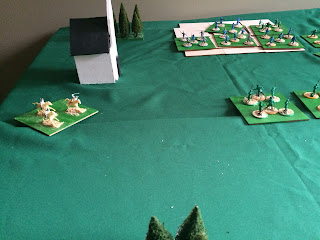This quote is from Neil Thomas, Wargaming Nineteenth Century Europe 1815-1878.
"Miniature wargaming has advantages over such contrivances as grids and ‘free kriegspiel’, however. Chief among these is the visual beauty of painted miniatures and three dimensional tabletops. Playing a structural wargame or a ‘free kriegspiel’ can be a curiously bland experience: one can feel almost divorced from the action. Miniature wargaming in contrast effectively predicates direct involvement, for the tabletop general identifies closely with the army he or she has collected and painted. This experience of empathy is a vital part of realism, allowing wargamers to put themselves in the position of historical generals: wherever they see an enemy unit routed they feel the elation of victory; the sight of their own units being destroyed engenders all the anguish and humiliation of defeat. For this is not an abstract body of men represented by counters, or sketches on a piece of paper–these are the wargamer’s very own little men. In this way, a miniature wargame can re-enact the historical experience in a manner very different, and infinitely superior to its physically anaemic ‘free kriegspiel’ rival. The problems of scale do however remain. The best approach to miniature wargames design lies in recognising their intractability, by appreciating that any game using figures is an abstract construct..."
While I am big fan of Thomas' One Hour Wargames, I was thrown off by the perspective revealed in the extract pasted above. Here are my concerns.
1. "The visual beauty of painted miniatures and three dimension tabletops." Beautiful is not an accurate description of all tabletops and figures, nor is it necessary. Bob Cordery used this phrase to describe what he is doing with his style of wargaming: 3D board game. Don't get me wrong; Cordery also uses painted figures. His approach to the board, however, is only beautiful if you like the abstract style. I very much like that style, but I am not sure I would describe it as beauty. Regarding the minis, seeing detailed painting just makes me feel inadequate. It is a turnoff.
2. "The tabletop general identifies closely with the army he or she has collected and painted." Yes, I am fond of the minis I have collected. Would I enjoy wargaming more if I carefully painted each mini and thus developed a relationship with it (him)? No, because the minis are so small I can barely see them. (Maybe this is why some people love tank warfare so much; at least you can easily see a tank.)
3. "The sight of their own units being destroyed engenders all the anguish and humiliation of defeat." I am a solo wargamer so both sides are my 'own units'. However, I do get an emotional reaction when one side is losing; I start to cheer for the underdogs.
Let me suggest this distinction: fine modeling and tabletop wargaming can be related activities but they need not be integrated. In other words, you can enjoy tabletop wargaming without being a fine modeler. And not all fine modelers enjoy tabletop wargaming. They might be just as happy building dioramas.
Where the two activities (fine modeling and wargaming) come together closely is in RPGs and skirmish games. When you have a small number of figures whose personal traits are important to the play of the game, painting might be more integral to the hobby. Or so it seems to me as an outsider. RPGs do not appeal to me.
Am I missing out by not developing a loving, empathetic relationship with my minis? HA! Give me a break. It is just a game. I send those little guys out to get destroyed in every battle. Fortunately, they can be resurrected for the next fight. I am not playing House; I am playing War. In my mind, the minis are first and foremost professional soldiers doing a difficult job. Their uniforms will be tattered and dirty, not neat and beautifully depicted. Heck, the green army can be green figures and the red army can be red figures. Paint makes no difference as long as I can distinguish the unit type: artillery, cavalry, regular infantry, or heavy infantry.
The enjoyment comes from the excitement of the battle and the uncertainty about the result, not from the paint.
PS. Have you ever noticed the guys who paint the inside walls of houses for a career often look a bit dopey? It is the paint. It fries their brains. And it is addictive, so they love painting.
Just sayin'.





















